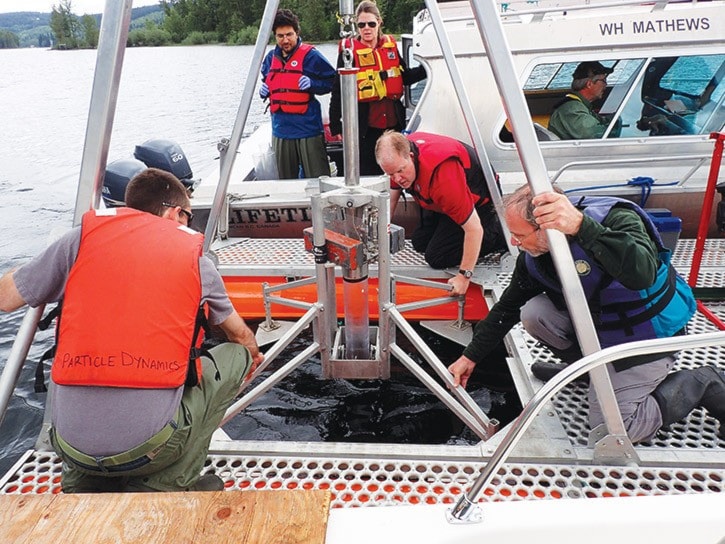Scientists at the Quesnel River Research Centre (QRRC) continue to collect sediment, water and aquatic life samples to help determine the impacts of the August 2014 Mount Polley Mine breach on the surrounding environment.
“We have been looking at the trends of the sediment suspended in the water column of Quesnel River that’s moving out of the lake, as well as the concentration of metals of the sediment from the riverbed,” said University of Northern BC professor Dr. Ellen Petticrew, who along with her colleague Dr. Phil Owens of UNBC, are part of the research team at the QRRC.
“In 2014 and 2015 the data from those sediment samples showed concentrations of copper quite a bit higher than the national guidelines for sediment quality,” Owens said. “At one point it looked like concentrations were steadily declining since the turn over of Quesnel Lake during the winter of 2015, but in the winter of 2016 there was another pulse of contaminated sediments that came out of the lake that got deposited on the bed of the river.”
The copper values were nearly as high as they were during the 2015 winter turnover, and during the snow melt in early spring of 2016 there was a trend showing that concentrations of arsenic, vanadium and other elements were on the rise, Owens said.
During a 10-day period in mid-July 2016, a team of eight researchers from QRRC/UNBC, the University of B.C., the Bedford Institute of Oceanography (Oceans and Fisheries Canada), and a volunteer from the community of Likely retrieved core samples of sediment and tailings from various locations on the bottom of Quesnel Lake.
“Our initial observations, although we haven’t had any of the samples analyzed yet, would confirm the ability of this fine material at the bottom of the lake to get re-suspended when the lake turns over,” Owens said.
The corer they were using can preserve the layer right at the point where the water meets the sediment, Petticrew said.
“What we are seeing is that the material that’s on the deposit, as well as in a halo around the deposit, is not consolidated at the surface. It can be mobilized,” she added. “This suggests that this material can come back into the water column.”
They suspect that the green colour of the lake is being caused by the re-suspension of the fine particles that cover a large area at the bottom of the west basin of Quesnel Lake, which is then delivered to Quesnel River.
While they don’t have the data back yet on those latest core samples, they will be looking at how easy it is to re-suspend that material from the bottom of the lake and what metal concentrations they contain.
Another aspect of their research will be to assess whether the material that’s being flushed out during spring snow melt is associated with the mine tailings, or if it is related to the natural background materials that are coming out of all of the watersheds and creeks into Quesnel Lake that were not impacted by the breach.
“We wanted to get out this spring for that, but didn’t have the resources,” Petticrew said. “We hope to do that next spring.”
Zooplankton samples from 30 metres below the surface of Quesnel Lake have been retrieved regularly since the breach and analyzed for metal content and a master’s student from UNBC has been collecting samples of primary producers that live on the rocks and shoreline at seven different sites on the lake.
“We are covering those two levels of the food web with the idea that the next level up is the fish,” Petticrew said.
The plan is to collaborate with Fisheries and Oceans Canada and the Ministry of Environment to collect fish and then the ministry is going to be analyzing the fish for metals.
Another group from UBC is currently doing a full lake characterization to determine how the lake behaves and what kind of sheer velocities exists at the bottom of the lake near Hazeltine Creek and where the sediment deposit is, while researchers from the University of Lethbridge will be on site next week to study organisms in the lake.
During an upcoming QRRC Open House, taking place on Saturday, Oct. 1, Owens, Petticrew and their colleagues anticipate they will be able to share information on this latest research, they said.
